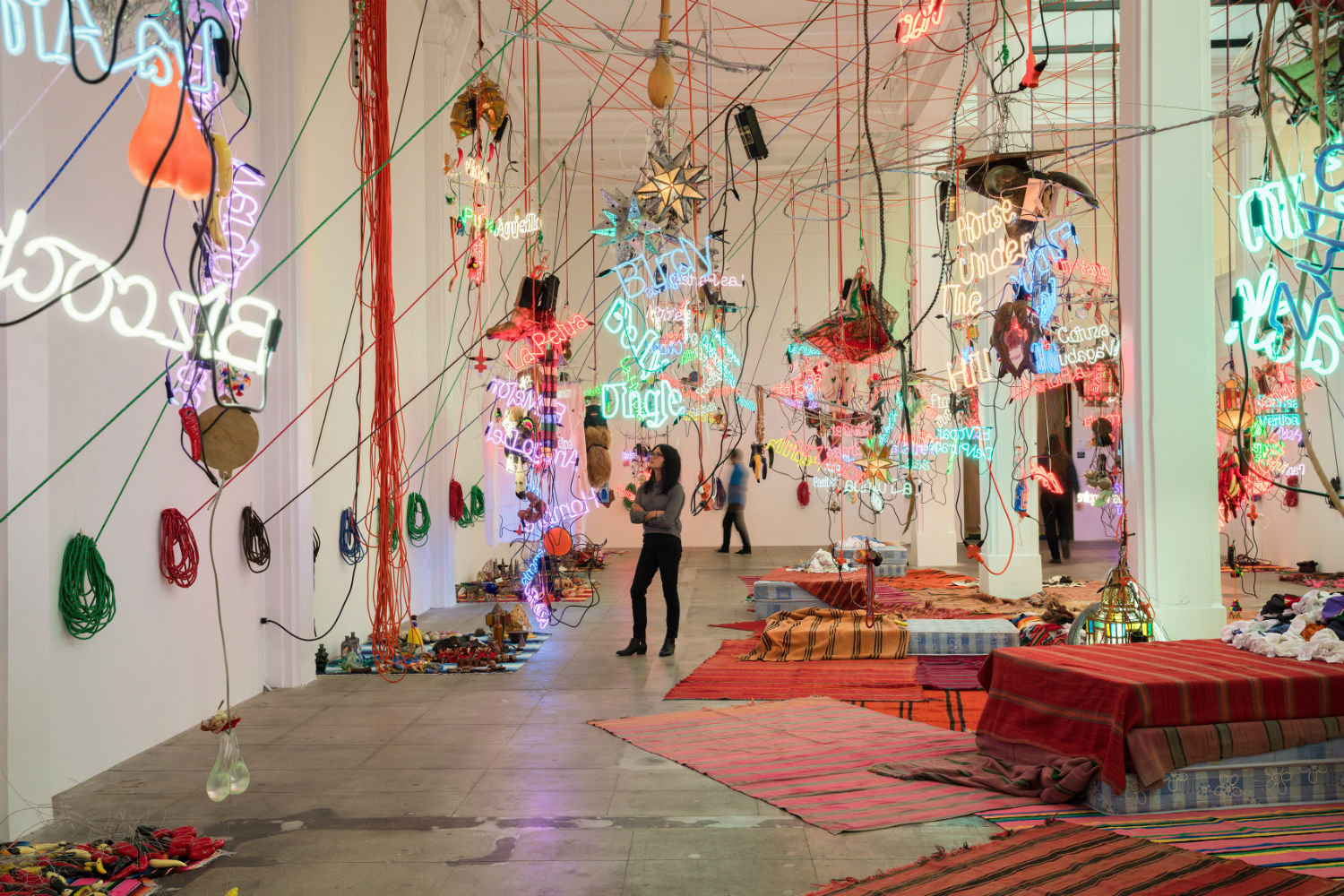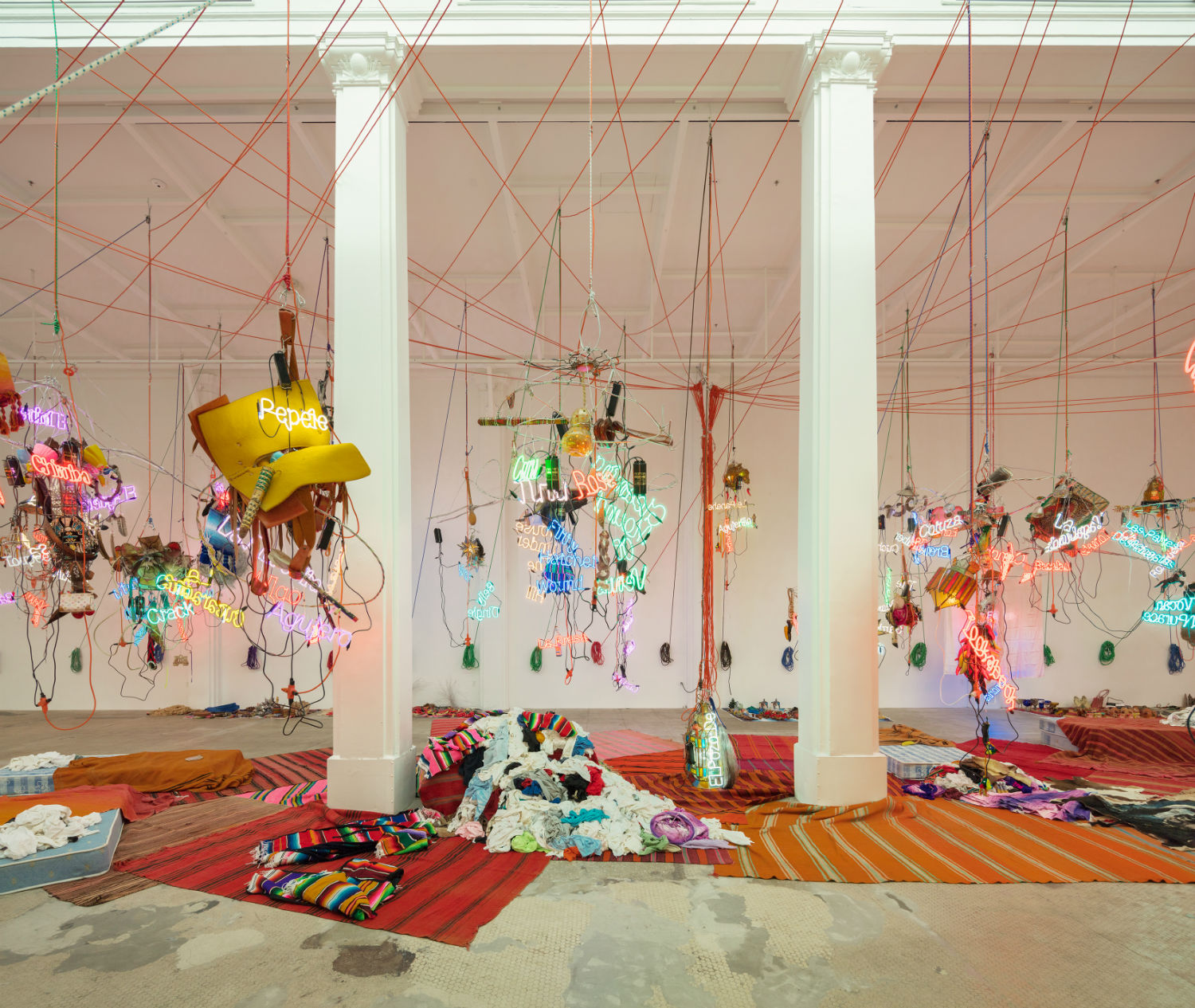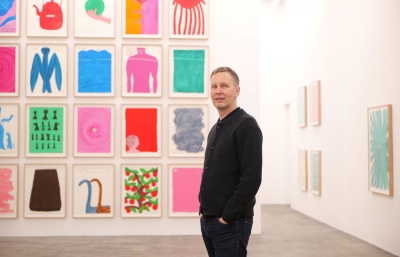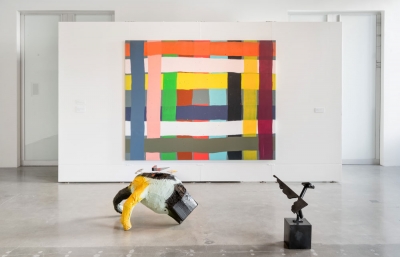
Jason Rhoades
An Appreciation
Interview by Gregg Gibbs
Where to begin explaining the work of LA-based artist Jason Rhoades? The immersive installations are wildly chaotic, crammed with a deluge of debris that resembles the aftermath of a ransacking, resulting in a confluence of space and scale. His room-sized sculptures comprise an array of disparate elements such as clusters of dime-store dream catchers, mounds of woven Mexican rugs, tangled strands of electrical cords, constellations of neon words strung together, car parts and machine gears, smoke machines, labyrinths of brushed metal tubes, towers of plastic paint buckets and hardware, stacks of cowboy hats, and hookah pipes… more objects than one can count or visually absorb, all organized with a scattered logic of his own design.
An awe-inspiring new exhibition of Rhoades’s work recently opened to much acclaim at Hauser, Wirth and Schimmel in LA. Occupying over 28,000 square feet of space, it brings together six major installations created over a lifetime that was tragically cut short by his untimely death at the age of 41. The esteemed curator and former partner of the gallery, Paul Schimmel, gave me a personal tour through the massive enclave of work by the renowned artist and explained the significance of the display.
Gregg Gibbs: How did you end up putting this show together? Did you work with Rhoades previously?
Paul Schimmel: I knew Jason from the time he was a student at UCLA and was studying with the conceptualist artist Richard Jackson. I met him during the installation of my show Helter Skelter at MOCA, when he was helping put together Jackson’s room of clocks. It’s a show that I’ve been wanting to do for a long time.
It’s my understanding that the work is not for sale. As a commercial gallery, how do you justify this curatorial presentation?
First of all, the gallery has worked with Jason since the beginning. From the get-go, this space in Los Angeles was really conceived to do museum-scale exhibitions to bring together both loans and institutionalized work, in addition to functioning commercially.
In my interactions with Jason, I was always impressed by his intellect and thought process—the way he navigated his ideas. It seems like they all relate to this concept where one thought leads to another idea, and a chain is started, though the last idea doesn’t necessarily relate to the first. What’s the underlying theme to these works conceptually?
I think he lived in his head and his heart. Jason was extraordinarily intelligent. He was seriously interested in the logic about how things relate to one another. But he also saw some kind of magical, spiritual connection. He would literally look for some unfathomable connection and draw it out. How one thing leads to the next is an organic process with a lot of artists. For him, the studio was always a boy’s playroom to tinker in, or a science lab for exploration, or a library to conduct research. His roots are in the 4H events at county fairs, selling stuff and showing animals.
"There is this dirty subject matter contrasting with this kind of cleanliness of the swedish ikea superstore and also jason's obsession with cleaning."
His work was about breaking down hierarchical thoughts about society and political ideas about sexuality. He was also interested in the difference between decorative art and fine art, in addition to an extraordinary interest in the commodity of objects. Jason was a shopper. His work is obsessive almost to the point of stockpiling. He was possessed by a compulsion to accumulate.
In this show, I think there is one piece that reflects how Jason thinks, and that is the centerpiece of the show called “The Creation Myth.” It is more organic in that it has to do with Jason’s mind and body. The theme of the human body is the armature. He used the structure of temples, of cabarets as institutions. You also have Black Pussy/London, which was similar in ways to a series of performances he conducted in LA. Those works are separated and meant to go their own way. One installation is Tijuana/Tangiers, which consists primarily of chandeliers filled with neon above an ordered collection of trinkets. All of these serve a form and function.
At the entrance to this exhibition is his first major installation titled Swedish Erotica and Fiero Parts, which was originally shown at Rosamund Felsen gallery in LA. The exterior of the building happened to be painted bright yellow, which, in turn, influenced the color palette for the piece. Can you explain the multi-layered meanings behind this odd gathering of objects?
The dominant organizing principle is the color. Initially, you can see that all of these disparate objects, which are made out of all sorts of informal components, like craft materials rather than fabricated materials, are held together by this yellow color, which, indeed, was based on the color of the strategically located gallery on Santa Monica Boulevard. I suspect that his reason to use yellow was a way to take over the entire building. He’s making the architecture of this former Hollywood studio space an extension of the piece by co-opting it. But what is also clear as we stand at the beginning of the exhibition laid out similarly to the show in 1994, is that he included many dispersive elements, such as pottery that he made in high school, which could be seen as juvenilia memorabilia, and objects covered in yellow legal pad paper, the color he had inherited from the gallery. Within that same logic, he used the fact that Marilyn Monroe had shot the famous photo on the cover of the first Playboy magazine in that space. His mother was of Swedish descent and she appears posing in photos much like Monroe. So he used these things to tie into other ideas that sprang from that. He parked a yellow Pontiac Fiero outside to designate the space as his personal garage. The logic being that it was some kind of artistic manipulation, which ended with this result.
Doesn’t it also tie into the classic early porn film, I Am Curious Yellow?
Yes, Swedish erotica and the types of pornography films that were being made in the Valley were part of the concept. He also brought in the influence of an Ikea store in Burbank that makes up the structure of the installation. So there is this dirty subject matter contrasting with this kind of cleanliness of the Swedish Ikea superstore and also Jason’s obsession with cleaning. Messy as much of all this might look, it’s based on the themed rooms you find in the store, whether it’s the living room, the bedroom or the dining room. It’s the mess of the imagination meeting the mess of the studio and he tries to bring order to it.
Wasn’t this installation broken up and sold in sections?
Jason looked at the impossibility of selling it all to one person and made these rational divisions based on functions of an Ikea store layout, breaking it up into individual islands. It did sell very well, which was quite surprising for a young artist’s first exhibition. MOCA and LACMA, along with important collectors, acquired the work. It was originally meant to be distributed in parts, but, like cells, they’ve come back together for this show, so they are home together again.

His first show was spectacularly successful and catapulted him to both national and international recognition. In many respects, he matured the quickest of the younger generation of artists. He was heavily influenced by the previous LA generation, like Mike Kelley, Chris Burden, Paul McCarthy and Charles Ray, and his career exploded internationally concurrent with that generation. So he was the youngest of that previous generation and the oldest of the new generation. Immediately, he was commissioned by important institutions to produce bigger shows.
Tell me about his next important piece, My Brother Brancusi, which was included in the 1995 Whitney Biennial.
It was very important to him to have his own room with no other artist in it, to know exactly the amount of space he had to create a floor plan. He made it large enough that the fire marshal would allow people to go through, but small enough that it was filled to look expansive and compressed. The room contains an accumulation of sculptural objects that sit on a rug defining what is permissible, and on the walls, images of the two key elements of the concept: his brother’s bedroom and Brancusi’s studio in Paris. He discovered this overlapping sensibility between the two. His brother becomes Brancusi in the history of sculpture. He chose arguably the most significant sculptor of twentieth-century Modernism, who had a huge impact on American art in an irreverent way. This work draws from the history of assemblage, installation art, and Fluxus. Jason engaged the audience with the creation of a doughnut factory, in a sense an homage to his brother, whose great ambition was to make a fortune with a doughnut business. So his brother’s desire becomes an endless column, as a reference to the classic Brancusi sculpture. Jason included his own obsession with the Home Depot aesthetic using homemade vehicles of transportation, such as motorbikes made out of dollies with lawnmower engines. He used to drive them around and make racing sculptures, which embody perpetual machines.
Wasn’t he a natural tinkerer who utilized lots of hardware store items from industrial catalogues? Was it related to a utilitarian American work ethic?
As a young man, he would be fixing things all the time in his suburban home. He would take apart video games, build things, always tinkering and constructing. One of his teachers at UCLA was Chris Burden, who liked to build and construct things, but more from an engineering standpoint. Jason’s goal is more poetic and intuitive—less about structure and more about form.
The doughnut maker is a central part of the piece. Tell me about these mounds of little doughnuts—did you have to fabricate them again? The original piece was created over twenty years ago.
As you know, conservators are very concerned about preserving the longevity of artwork. What’s really scary is we thought we’d have to fire up the doughnut maker again and make a new batch, but oddly enough—this may be shocking—these are the originals. The doughnuts have so much MSG in the recipe that they have survived in better shape than other elements of the work. Which is something to think about in the stuff we eat and what it does to our digestive system.
What strikes me is the unifying element of color. It’s almost painterly.
Both the red and the yellow in the first installations could be considered painterly. That’s not the case as you see his career going forward. Armatures take over the unifying structure that colors had in the early work. You later have the shelving and metal pipes and the hanging chandeliers with the neon, each repeated again and again in a similar fashion. The neon brings multiple colors to the scene.
When you assemble a show that is so busy, does everything have its place, or is it somewhat random? The average viewer might consider this just a haphazard bunch of clutter. Did the artist have a defined layout for everything?
That is a great question in regard to The Creation Myth, which has several stacked tables with wires all over the place, hundreds of magazines and bric-a-brac, piles of shredded faxes, things that really reflect the end of the analog age moving into the digital era. There’s a volcano blowhole that emits a smoke ring every minute, much like an exploding anal orifice. There are also so-called brain objects that represent the mind, such as trains of thought represented by a toy train circling an array of surveillance cameras transmitting to monitors. All of it is about the mind and body of the artist creating works of art, sort of the process by its own making.
Literally thousands of objects have been painstakingly entered into a database and catalogued, each having a very specific location with a specific meaning that makes connections. His assistants, who worked on it, originally helped to make playbooks that are used to recreate the installation. This particular work, which has traveled around the world, was donated by a collector to the Berlin Museum. It is one of the most complex pieces that Jason made. People look at it and think it could go anywhere. Not so.
It’s such a visceral experience in person, sort of a sloppy intellectualism playing with the realms of the high and low. Is that what he was attempting to accomplish?
He captured a kind of organic and intuitive unconscious approach to art making, but in fact he was very rigorous in the conceptual links that he made between thousands of discrete visual and auditory information. I don’t think he saw his work like what the assemblagist artist Alan Kaprow did with his happenings—something that somebody else could recreate. It wasn’t open-ended, it was fixed in that respect. Right from the beginning, from Swedish Erotica until the end, he always had these very deliberate road maps for the development of the work, and even more carefully mapped out its dissemination in subsequent locations.
What’s the meaning of the huge room filled with brightly colored neon sculptures hanging above patterned carpets? I’m reminded of the work of Bruce Nauman and other artists who work with neon, like Dan Flavin’s fluorescent tubes and the LA Light and Space movement. But this is different, like he’s drawing with neon signs.
Most famous is Nauman with the use of words and reversal language in neon. Most light and space artists used daylight or artificial lights, but these are like bar signs straight from the street, kind of like going back to the reason neon normally functions as commercial signage. So Jason has taken from a large database of words referring to woman’s genitals in a multitude of languages, and he’s turned them into colorful signs that are at once rendered abstract. This piece can best be experienced as one would worship in a temple. It’s called My Medea/My Ermitage, as in the Hermitage museum in Russia. It is both a mosque and a museum. To experience this, you take off your shoes, sit on the carpets and take it all in. It is the only piece in the show that you could call viewer friendly because you can get a lot of people in here. This installation has a lot of space to sit down and gaze at the neon. The other rooms in the show have limited access. Only a few people are allowed in those spaces because of the density of the work. You have to watch yourself carefully. We had almost 6,000 visitors for the opening day. Only a third of them made it into the exhibition. I think Jason would have been overwhelmed by the turnout and response.
Is part of the reason for that popularity because he never showed in LA after his first exhibition? Why is it that he never had a gallery or museum show here again—even though this is where he lived?
His last show was here, but it wasn’t really a traditional art show. It was in a warehouse where he was self-representing by holding cabaret/soirée events called Black Pussy. I think he could have shown anywhere here if he wanted. But the truth is, because of the kind of representation that he had in New York with David Zwirner, and Hauser and Wirth in Europe, there were more opportunities on the East Coast and in Europe than in LA. Those opportunities had more to do with the complex realization of the installations. In his case, he was able to get institutions and collectors to pay for it, allowing him to make new work on his terms, which is what most artists like to do. His work, in an ongoing way, was a practice to keep what he called “the machine” going. He saw himself as a worker and believed that the body inside the machine could regenerate itself.
I do think in a funny way that what was so hard in doing a show with Jason here in Los Angeles was that he wanted a different kind of space. I think he liked being a stranger in his own hometown, not having to sleep where he worked. He lived a studio life here with artist friends, but when he was on the road, he got to hang out with collectors and museum people. He still had a big following here and was very influential.










